| JANUARY 2020 |
| Sh˘chikuza (ďsaka) |  |
| Dates | 3 ~ 27 January 2020 Kotobuki Hatsuharu ďkabuki Congratulation Early Spring Grand Kabuki |
| MatinÚe |
Tsuzura Ori (Ohide Seishichi) |
| Evening |
Yoshitsune Senbon Zakura Yűgiri Nagori no Sh˘gatsu ďatari Fushimi no Tomikuji |
| Casting |
Living National Treasure Kataoka Hidetar˘, Nakamura Ganjir˘, Nakamura Senjaku, Matsumoto K˘shir˘, Kataoka Ainosuke, Nakamura Kazutar˘, Band˘ Takesabur˘, Ichikawa En'ya, Sawamura S˘nosuke, Nakamura Toranosuke, ďtani Hirotar˘, Nakamura Jűjir˘, Arashi Kitsusabur˘ |
| Comments |
The traditional two programs for the New Year Grand Kabuki at the Sh˘chikuza.
|
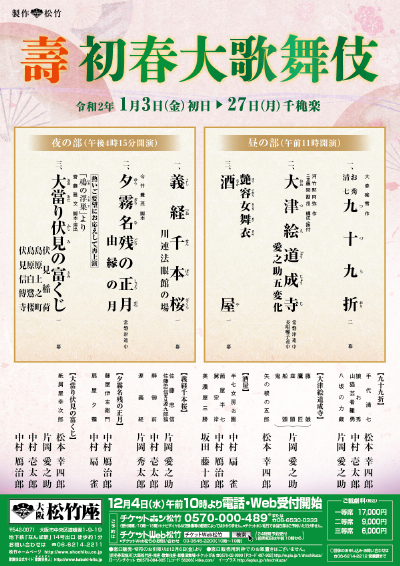 |
| National Theatre (T˘ky˘) |
| Dates | 3 ~ 27 January 2020 |
| Program | |
| Casting |
Living National Treasure Onoe Kikugor˘, Nakamura Tokiz˘, Onoe Kikunosuke, Onoe Sh˘roku, Nakamura Baishi, Ichikawa Danz˘, Band˘ Rakuzen, Ichimura Manjir˘, Band˘ Hikosabur˘, Kataoka Kamez˘, Band˘ Kamez˘, Kawarasaki Gonjűr˘, Nakamura Mantar˘, Ichimura Takematsu, Onoe Ukon, Band˘ Shűch˘, Ichimura Hikaru, Onoe Sakon, Ichimura Kitsutar˘ |
| Comments |
Revival at the National Theatre of Tsuruya Nanboku IV's new year sogamono drama "Okuni-iri Soga Nakamura", which was premiered in the 1st lunar month of 1825 at the Nakamuraza. It is entitled "Kiku Ichiza Reiwa no Adauchi". As this is usually the case for the new year program, the zagashira is Living National Treasure Onoe Kikugor˘. Kiku Ichiza in the new title means the troupe led by Kikugor˘, Reiwa is of course the Reiwa era and adauchi (revenge) is a hint at the sogamono. Two hanamichi are used in this production.
|
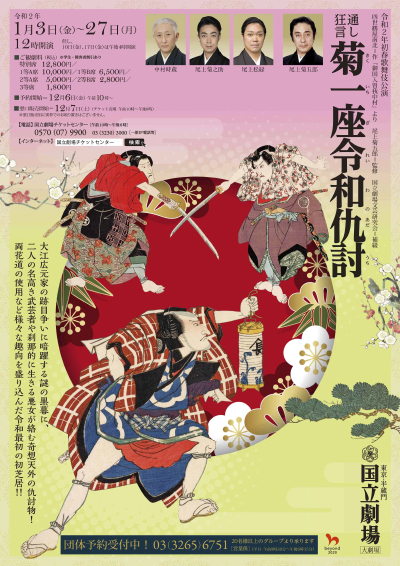 |
| Dates | 18 January 2020 (Dent˘ Kabuki Hozonkai Kenshű Happy˘kai) Training Recital of the Organization for the Preservation of Kabuki |
| Program |
|
| Comments |
25th Training Recital at the National Theatre produced by the Organization for the Preservation of Kabuki. The final item in the program, "ďgiri", is staged with Living National Treasure Onoe Kikugor˘, Nakamura Tokiz˘, Onoe Kikunosuke, Ichikawa Danz˘ and Onoe Sh˘roku.
|
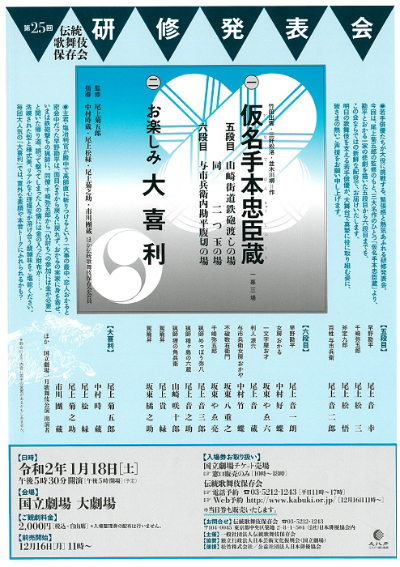 |
| Kabukiza (T˘ky˘) |  |
| Dates | 2 ~ 26 January 2020 Kotobuki Hatsuharu ďkabuki Congratulation Early Spring Grand Kabuki |
| MatinÚe |
Daigo no Hanami |
| Evening |
Yoshitsune Koshigoej˘ (Goto Sanba) |
| Casting |
Living National Treasure Nakamura Kichiemon, Living National Treasure Nakamura T˘z˘, Matsumoto Haku˘, Nakamura Shikan, Nakamura Jakuemon, Nakamura Baigyoku, Nakamura Kaishun, Nakamura Fukusuke, Ichikawa Ennosuke, Nakamura Kankur˘, Nakamura Shichinosuke, Nakamura Karoku, Nakamura Matagor˘, Ichikawa Monnosuke, Ichikawa Komaz˘, Matsumoto Kingo, Ichikawa Omez˘, Ichikawa Emisabur˘, Ichikawa Emiya, Nakamura Takanosuke, Ichikawa Danko, Nakamura Hashinosuke, Nakamura Fukunosuke, Nakamura Kichinoj˘, Nakamura Jűjir˘, Nakamura Kantar˘, Nakamura Ch˘zabur˘ |
| Comments |
The traditional two programs for the New Year Grand Kabuki at the Kabukiza.
|
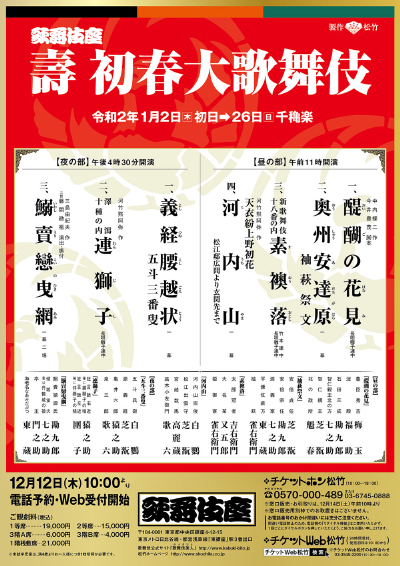 |
| Shinbashi Enbuj˘ (T˘ky˘) |  |
| Dates | 3 ~ 24 January 2020 Hatsuharu Kabuki K˘en Early Spring Kabuki Performances |
| MatinÚe |
Gion Sairei Shink˘ki (Kinkakuji) Yukibotaru Koi no Taki |
| Evening |
Kami no Megumi Wag˘ no Torikumi Setsugekka Mitsu no Nagame (Nakakuni) |
| Casting |
Ichikawa Ebiz˘, Nakamura Baigyoku, Kataoka Takatar˘, Ichikawa Sadanji, Ichikawa Udanji, Nakamura Shid˘, Nakamura Kotar˘, Nakamura Kangyoku, Ichikawa Sai'nyű, ďtani Tomoemon, Nakamura Kikaku, Ichimura Kakitsu, Kataoka Ichiz˘, Sawamura Yoshijir˘, Ichikawa Kudanji, ďtani Hiromatsu, Nakamura Kamenoj˘, Kataoka Matsunosuke, Ichikawa Otora, Nakamura Tamatar˘, Horikoshi Kangen, Ichikawa Botan |
| Comments |
The traditional New Year Kabuki at the Shinbashi Enbuj˘ with a troupe led by the young star Ichikawa Ebiz˘.
|
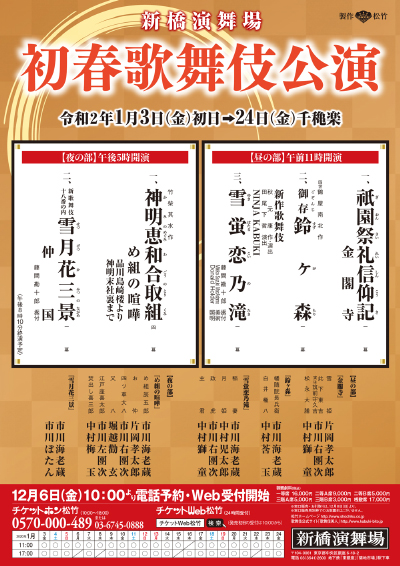 |
|
|||
| Dates | 2 ~ 26 January 2020 Shinshun Asakusa Kabuki New Year Asakusa Kabuki |
||
| MatinÚe |
Otoshidama (Nenshi Goaisatsu) Hana no Ranpei |
||
| Evening |
Otoshidama (Nenshi Goaisatsu) |
||
| Casting |
Nakamura Kinnosuke, Onoe Matsuya, Band˘ Minosuke, Nakamura Hayato, Nakamura Kash˘, Band˘ Shingo, Nakamura Yonekichi, Nakamura Hashinosuke |
||
| Comments |
The yearly show for young promising actors at the Asakusa K˘kaid˘ in Asakusa, a lively and colorful neighboorhood that keeps the scent of old Edo.
|
||
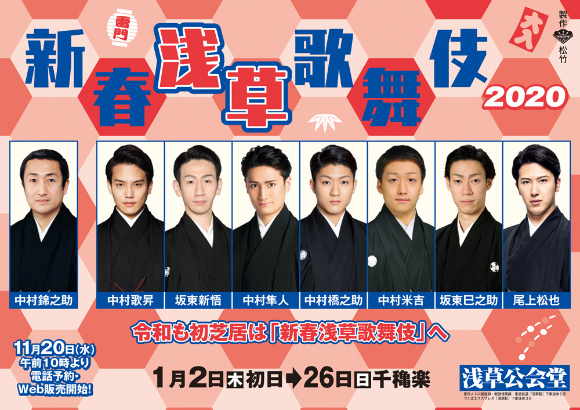 |
| Dates | 30 ~ 31 January 2020 Baish˘kai |
| Program |
Shiki Sanbas˘ Takeminakata |
| Casting | |
| Comments |
2nd edition of the Baish˘kai, a gala program which stars Nakamura Shinobu and Ichikawa Emino. |
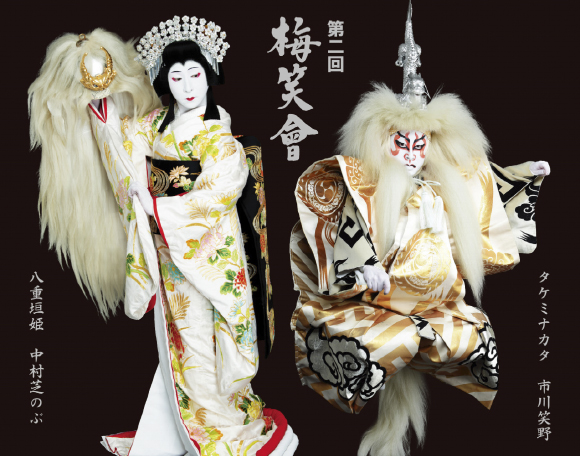 |
|
|
| Dates | 11 ~ 18 January 2020 Zenshinza Hatsuharu Tokubetsu K˘en Zenshinza Early Spring Special Performances |
| Program | |
| Casting |
Fujikawa Yanosuke, Kawarazaki Kunitar˘, Tadamura Shin'ya, Tamaura Yűnosuke |
| Comments |
The traditional Zenshinza New Year performances in Ky˘to at the Minamiza. |
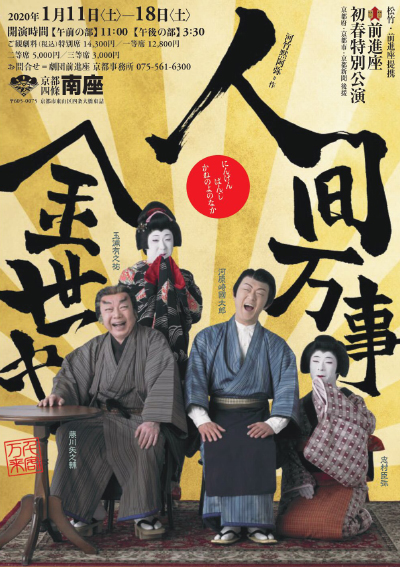 |
| Misonoza (Nagoya) |  |
| Dates | 2 ~ 4 January 2020 Shinshun Tokubetsu Buy˘ K˘en New Spring Special Dance Performances |
| Program |
Yuki Sankyoku Ito no Shirabe Akoya Kotozeme Kane-ga-Misaki |
| Casting |
Living National Treasure Band˘ Tamasabur˘ |
| Comments |
A special new year Buy˘ program in Nagoya at the Misonoza, starring Living National Treasure Band˘ Tamasabur˘ |
|
|
| Contact | Main | Top | Updates | Actors | Plays | Playwrights | Programs | Links | FAQ | Glossary | Chronology | Illustrations | Prints | Characters | Derivatives | Theaters | Coming soon | News |